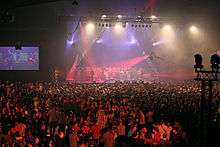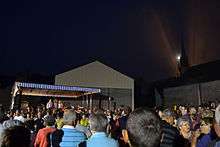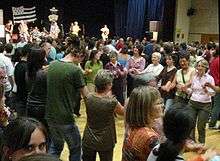Fest Noz
A Fest Noz (Breton for night festival) is a Breton traditional festival, with dancing in groups and live musicians playing acoustic instruments.

Although it is all too easy to write off the fest nozou and fêtes folkloriques as modern inventions, most of the traditional dances of the Fest Noz are ancient, some dating back to the Middle Ages, providing a way for the community to grasp hold of its past and relish a deep sense of being with ancestors and with place.[1]
The plural in Breton is festoù-noz, but the Goadec Sisters (a family of traditional singers) used to say festnozoù, and the French may also say in French des fest-noz.
On 5 December 2012 the fest-noz was added by UNESCO to the Representative List of the Intangible Cultural Heritage of Humanity.[2]
Fest-noz

A fest-noz (plural festoù-noz) is a traditional dance festival in Brittany. Most Breton dances are social dances, in a group. Currently, many festoù-noz are also held outside Brittany within diaspora, bringing the Breton culture to life outside Breton territory. This term is known since the end of the 19th century but is given as a name only since the 1950s.
In the past, the dances were sometimes used to trample the ground to make a firm earth floor in a house or a solid surface for farm work (the "aire neuve" dances), to which people from the neighbourhood were invited, which explains the presence of stamping movements in some of the dances. For a long time the church banned "kof-ha-kof" (stomach-to-stomach) dances, meaning dancing in pairs. These festivals were a chance for young people to meet and size each other up, on a social level, by their clothes, and to see how quickly they got tired, since dances sometimes continued for a long time and involved complex and swift steps that required effort and skill.
These days, "Festoù Noz" are still very popular, mixing the different generations. Most of the villages have a fest-noz at least once a year, organised by the sports clubs, the school, etc... It is a way to express their culture and identity, and to share common values with friends of a night. As in many group folk dances, one talks of sometimes reaching a trance state because of repetitive music, and physical exertion. During the summer and tourist season, in many ways, taking part in a fest-noz is for many people like an alternative way of going to a night club.
The dances

There are hundreds of traditional dances, of which the most well-known are gavottes, the an dro, the 'hanter dro, the plinn and the Scottish. During the fest-noz, most dances are practised in a chain or in a circle (everyone holds hands), but there are also dances in pairs and "choreographed" dances, meaning dances enriched with precise artistic elements (sequences, figures, etc.).
The major study on Breton dancing is "La tradition populaire de danse en Basse-Bretagne", book written from his thesis dissertation, by Jean-Michel Guilcher - new edition by Coop-Breizh - Chasse-Marée/Armen - 1995.
The music
There are principally two types of music at these festivals: music sung a cappella (kan ha diskan, ...), accompanied with music or purely instrumental. Before the invention of microphones and amplified instruments, the instruments that were most often used were the bombarde (a sort of oboe or shawm) and the Breton bagpipes (binioù kozh), due to their high volume. Also popular was the diatonic accordion, the clarinet, and occasionally the violin and the hurdy-gurdy. After the Second World War, the Scottish bagpipes (binioù bras) also became common in Brittany thanks to bagadoù (pipe bands) and thus often replaced the binioù-kozh. The basic clarinet (treujenn-gaol - "cabbage core" in Breton) had all but disappeared but has regained popularity over the past few years.
Other than the traditional instruments, there are nowadays groups with many different styles of music ranging from rock, jazz, to punk and also mixes with styles from other countries. String instruments (the violin, the double-bass, the acoustic guitar, the electric guitar, the bass guitar) and North-African percussion instruments have long since been adopted. To varying degrees, some Fest-Noz groups also use electronic keyboards and synthesisers (Strobinell, Sonerien Du, Les Baragouineurs, Plantec...). Brass instruments are becoming increasingly commonplace, often bringing with them sounds approaching those of oriental music.
The programme
.jpg)
Just after the revival of the 1970s, the standard was to alternate a couple of singers (a cappella or "kan a diskan") and a couple of musicians (biniou - bombarde generally). It was common to see the holding of «free stages». Currently, couples of singers (kanerien) and couples of musicians (sonerien) play alternately with a band. Bands play more instrumental music and often the practice of the dance is different from the two other ways to conduct the dancers.
Between every "suite" (three dances), there are short breaks where dancers socialise by chatting to other dancers or visiting the traditional buffet of local dishes like crêpes, galettes-saucisses, far Breton, kouign-amann with local cider, beer, and chouchen, a mead-like drink made from fermented honey.
See also
- Balfolk
- Ceili
- Music of Brittany
- Nos Lowen
- Troyl
- Faroese dance
References
- Cunliffe, Barry W. (2003). The Celts: a very short introduction. Oxford UP. p. 135. ISBN 978-0-19-280418-1.
- UNESCO - Intangible Heritage Section. "UNESCO Culture Sector - Intangible Heritage - 2003 Convention :". unesco.org. Archived from the original on 2013-08-26.
External links
| Wikimedia Commons has media related to Fest-noz. |
- Official UNESCO video presentation
- Fest Noz Spezet
- Fest-noz included on the Unesco Intangible Heritage List - The official website of France (in English)